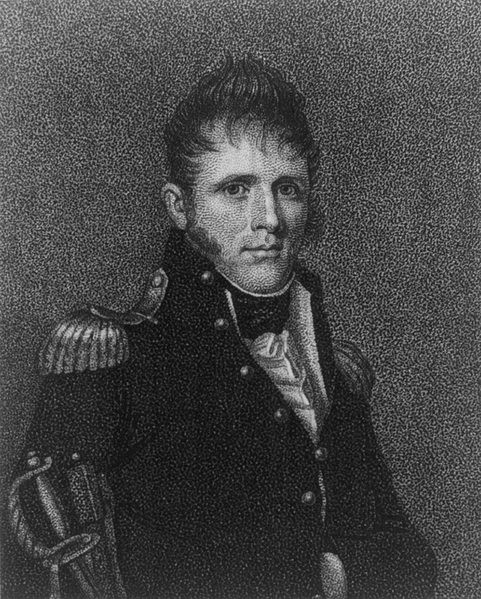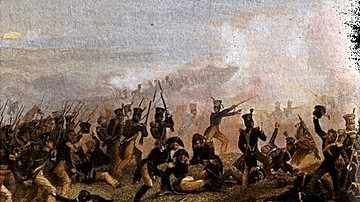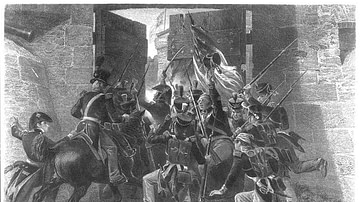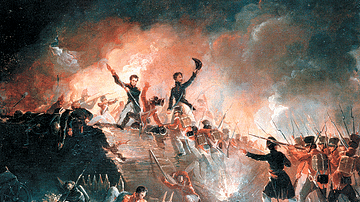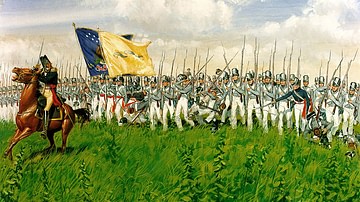The Battle of Chippawa (5 July 1814) was a major battle in the War of 1812, in which a US army proved its newfound discipline by defeating British regulars during the Americans' third attempted invasion of the Niagara Peninsula. Though the battle resulted in a US victory, the ensuing Battle of Lundy's Lane ended in a stalemate, dooming the invasion.
Background: The Last Invasion of Niagara
By the end of spring 1814, it was becoming clear that the chances for the United States to conquer Canada were slipping away. In Europe, French Emperor Napoleon I had finally been defeated and exiled to the island of Elba, freeing up thousands of veteran British soldiers to be sent across the Atlantic to fight the Americans. The British, previously outnumbered in North America, had been forced to stay on the defensive in the last two years of fighting; now, with this influx of battle-hardened reinforcements, they could easily drive down into New York, or even open up new frontiers anywhere else along the United States' vulnerable coastline. It was essential, therefore, for the Americans to make one last effort to establish a foothold in Canada, to give them any small advantage for when the British troops arrived. A successful invasion of Canada would, moreover, give the Americans a bargaining chip for the peace negotiations, which were soon to be underway in Europe, in the Flemish town of Ghent.
Command of the American army stationed at Buffalo, New York, was given to Major General Jacob Brown, the latest in a long string of luckless American generals ordered to cross the Canadian border. Brown's own orders, coming straight from the pen of Secretary of War John Armstrong Jr., had been quite casual in tone: "To give…immediate occupation to your troops, and to prevent their blood from stagnating, why not take Fort Erie?" (quoted in Berton, 702). The capture of Fort Erie would indeed give the Americans a strong toehold on the Niagara Peninsula, which could be used as a base of operations for subduing the surrounding lands. Brown, deciding that such a campaign had the opportunity to restore honor for the US Army if nothing else, began planning the invasion. Since his troops were ragged and undisciplined, he ordered one of his subordinates, Brigadier General Winfield Scott, to whip them into shape in preparation for the upcoming campaign.
At only 28 years old, Scott was perhaps the most up-and-coming officer in the US Army. Broad-shouldered, muscular, and towering over his fellow officers at a height of six-foot-five (195 cm), Scott was already well-known for his exploits in previous battles and was revered as a brilliant disciplinarian and tactician. Indeed, Scott's baggage wagon was bursting with military treatises and biographies of generals, which he could quote at length from memory; one of these works was the 1791 manual that had been used to drill the French Revolutionary Army, which Scott now employed to turn his ragtag volunteers into true soldiers. Under Scott's supervision, the American soldiers at Buffalo underwent daily drills that lasted anywhere between seven and ten hours; one captain wrote with astonishment that "General Scott drills and damns, drills and damns, drills and damns, and drills again" (quoted in Taylor, 383). Parades and inspections were conducted weekly, with Scott regulating every small detail from the contents of a soldier's knapsack to the angle of his arm while saluting. Scott worked to increase the health and morale of his soldiers, making sure that they always had access to fresh food and clean uniforms. He mandated that each man bathe three times a week with soap, thereby reducing the risk of disease. He did not hesitate to impose strict discipline and once made a show of having five deserters executed by firing squad.
After just three months, Scott had completely transformed his soldiers into a force that was better disciplined, better supplied, and better trained than any other US army in the war. If there was any American force that could hope to resist the battle-tested British regulars coming over from Europe, this was it. Pleased with Scott's progress, General Brown prepared to launch his invasion, supplementing his troops with 1,000 militia volunteers under Peter B. Porter, a prominent New York politician. 500 Seneca warriors from Buffalo Creek were also assigned to Porter's command. Brown longed for his army to gain the respect of the British and warned his officers not to plunder private property after crossing into Canada; they were to conduct themselves with the honor of a true European army, to wash out the stains of the previous years of defeats and humiliations.
Burning of Dover
On 15 May 1814, a teenage girl named Amelia Ryerse was inside her home in the small Canadian town of Dover, along Lake Erie. She heard the sudden sound of dogs barking and went outside to see what the matter was, only to be greeted by a startling sight. "When I looked up," she would recall, "I saw the hill-side and fields, as far as the eye could see, covered with American soldiers." Indeed, 700 Pennsylvania volunteers under the command of Lt. Colonel John B. Campbell had come to wreak havoc on Dover, in revenge for the British-Canadian raids on several New York towns the previous December. The Americans burned 20 houses, twelve barns, three flour mills, and three distilleries, shooting all the livestock they could find. "Very soon," Ryerse lamented, "we saw columns of smoke arise from every building, and of what had been a prosperous homestead, at noon there remained only smoldering ruins" (quoted in Taylor, 385).

When Brown learned of the burning of Dover, he was incensed. He immediately expressed his apologies to the British commander and had Campbell court-martialed. Thanks to his popularity, however, Campbell was let off with only a mild rebuke and was reinstated in the army in time to join in the invasion. This was not a promising start for Brown, who was counting on the cooperation – or at least the apathy – of the Canadian people. Nevertheless, he opted to go ahead with the assault on Fort Erie. On the night of 2-3 July, the army crossed the Niagara River. Like Brown, every officer was determined to redeem the reputation of the US Army; as Major Thomas Sidney Jesup explained, "if we could do nothing else, we might at least strike such a blow as to restore the tarnished military character of the country" (quoted in Taylor, 387). For this purpose, each of Brown's officers decided to go into battle brilliantly decked out in bright red sashes and gold epaulettes, to prove to the British that they were not the same motley force that had fumbled the invasions of the previous two years.
Capture of Fort Erie
In the predawn stillness of 3 July 1814, the American boats approached the Canadian shoreline. General Scott, determined to be the first man ashore, jumped prematurely out of his boat, only to discover that the water was too deep. He flailed in the water, weighed down by his ostentatious uniform, until his men pulled him back on the boat; no one laughed as to not upset the general's massive ego. Once the boats were a little closer to shore, Scott once again jumped into the water and this time successfully began wading out toward land, followed by his men. The British garrison of Fort Erie, taken by surprise, soon realized they were heavily outnumbered by Brown's army of about 3,600 men and surrendered. The third – and final – American invasion of the Niagara Peninsula had begun.
Having captured Fort Erie without much difficulty, the Americans were now faced with the Right Division of the British Army, tasked with the defense of Niagara. This force, under the command of Major General Phineas Riall, was encamped at a strong position along Chippawa Creek, with cannon guarding the sole bridge across it. The British force consisted of about 1,350 regulars, 350 Native American warriors, and 200 Canadian militia. On the clear, warm morning of 4 July – Independence Day for the Americans – Scott's brigade pushed back the forward elements of Riall's army, which had been thinly stretched across the fields and orchards that made up the Niagara countryside. Although Riall wrote to the Upper Canadian capital of York to request reinforcements, he was unconcerned, working as he was under the false assumption that Fort Erie was still holding out and that the American army was much smaller than it really was. The British, therefore, dug in at Chippawa and awaited the arrival of Scott's brigade. After months of ceaseless drilling and training in their camps outside Buffalo, Scott's soldiers were about to be put to the test.
Battle
At dusk on 4 July, Scott ordered his men to set up camp for the night at Street's Creek, less than a mile away from the British position at Chippawa. Here, he was soon reinforced by another brigade under Brigadier General Eleazer Wheelock Ripley, who brought word that Peter Porter was also on his way with his militiamen and Seneca warriors. With these reinforcements, Scott knew he outnumbered the British and decided to try to force his way across the Chippawa bridge the next morning. But it would be Riall, not Scott, who would act first. At 7 a.m. on 5 July, the British pickets, hidden in the tree line across the creek, began firing on the American sentries. The Americans, startled, threw themselves to the ground to hide amongst the tall grass; a second crackle of British musketry was enough to send them running back to the main camp.
As the morning sun continued to climb into the summer sky, skirmishing intensified along the creek. General Brown, who had arrived on the scene not long before, wanted to clear out the enemy skirmishers from the woods as soon as possible and ordered Porter's militiamen to take care of them. Porter was at first reluctant to adhere to the order, fearing that he was being used as a ‘sacrificial lamb', but his worries were soothed when Brown promised to send Scott's brigade in support. Cautiously, Porter led his militiamen and Seneca warriors forward at 2 p.m., moving single file toward the woods. But as they crept forward, they had no way of knowing that Riall had ordered a full-scale attack of his own and had moved his British regulars into the woods. By the time Porter's militia realized what they were walking into, it was too late; no sooner did the British troops unleash their first musket volley than the militiamen began to run back to the camp at Street's Creek.
So far, the British were not surprised by the undisciplined conduct of the American troops, as they had seen them fumble such assaults before. This made some of the British let their guard down, assuming that all the American troops would be of a similar quality. But Scott was determined to prove them wrong. By 5 p.m., adorned in full dress uniform, he was leading his brigade forward from Street's Creek, unflinching as British cannonballs soared overhead. Captain Nathan Towson, in charge of Scott's artillery, drew up three 12-pounder cannons on the road and opened fire in the direction of the British artillery; one of Towson's cannonballs struck an ammunition wagon, with the explosion knocking most of the British guns out of action.
Scott's infantrymen, meanwhile, kept on marching, bayonets glinting in the afternoon sun. Since Scott had not been able to procure the standard blue cloth for US Army uniforms, his men were dressed in a light gray uniform, leading the British to believe they were simply militia. The redcoats watched them come with little unease, until Scott, riding back and forth in front of his men, called out that Independence Day may have been over but "Let us make a new anniversary for ourselves!" With that, the American regulars let out a cheer and surged forward. With expert precision, they moved forward, halted, loaded their muskets, and fired in unison. Too late did General Riall realize these were not the undisciplined militia he thought they were. "Why," he was heard to exclaim, "those are regulars!" (quoted in Berton, 710).
This realization prompted Riall to action, and he sent two regiments forward to meet Scott's advance. The air filled with the sound of fifes and drums as the scarlet-coated line moved out, coming within range of the American cannons. Captain Towson, spotting the opportunity, ordered his guns to rake the oncoming British soldiers with canister shot. This had a devastating effect, as pieces of shrapnel ripped holes in the British line. Finally, the British and American lines came within 100 yards (90 m) of each other, with both sides holding their ground for 20 long minutes as they traded volleys. The British broke first and soon withdrew back to their entrenchments behind Chippawa Creek. The Americans did not pursue. As dusk set in, the British officers were left to wonder how the American regulars had become so proficient. "[These] troops," said one bewildered officer, "are far superior to everything they have brought into the Country during the present war" (quoted in Taylor, 388).
Aftermath
The Battle of Chippawa resulted in a stunning US victory, for the price of 328 American casualties, compared to the 535 losses sustained by the British. Even as the American officers argued with one another about the share in the credit they should be given in Brown's official report – as such credit could lead to promotions – they all agreed that the US Army had finally proved itself disciplined enough to stand up to British regulars. The soldiers of Scott's brigade, of course, were lauded as the heroes of the moment, and, indeed, the gray uniforms they wore into the battle would soon become immortalized as the uniforms worn by the cadets at the West Point Military Academy. The British, for their part, came to respect their American adversary a little more.
Shortly after the battle, many of Riall's Native American allies deserted him, depriving him of much-needed scouts. Unnerved, the British general opted to abandon his strong position at Chippawa and march along the Niagara River north, toward Fort George. Brown lacked the resources to pursue and decided to move his own army to Queenston, where he hoped in vain for support from Commodore Isaac Chauncey and the US fleet on Lake Ontario. These maneuverings would ultimately result in the bloody Battle of Lundy's Lane (25 July 1814), an engagement that, while inconclusive, would spell an end to the final US invasion of Niagara.


